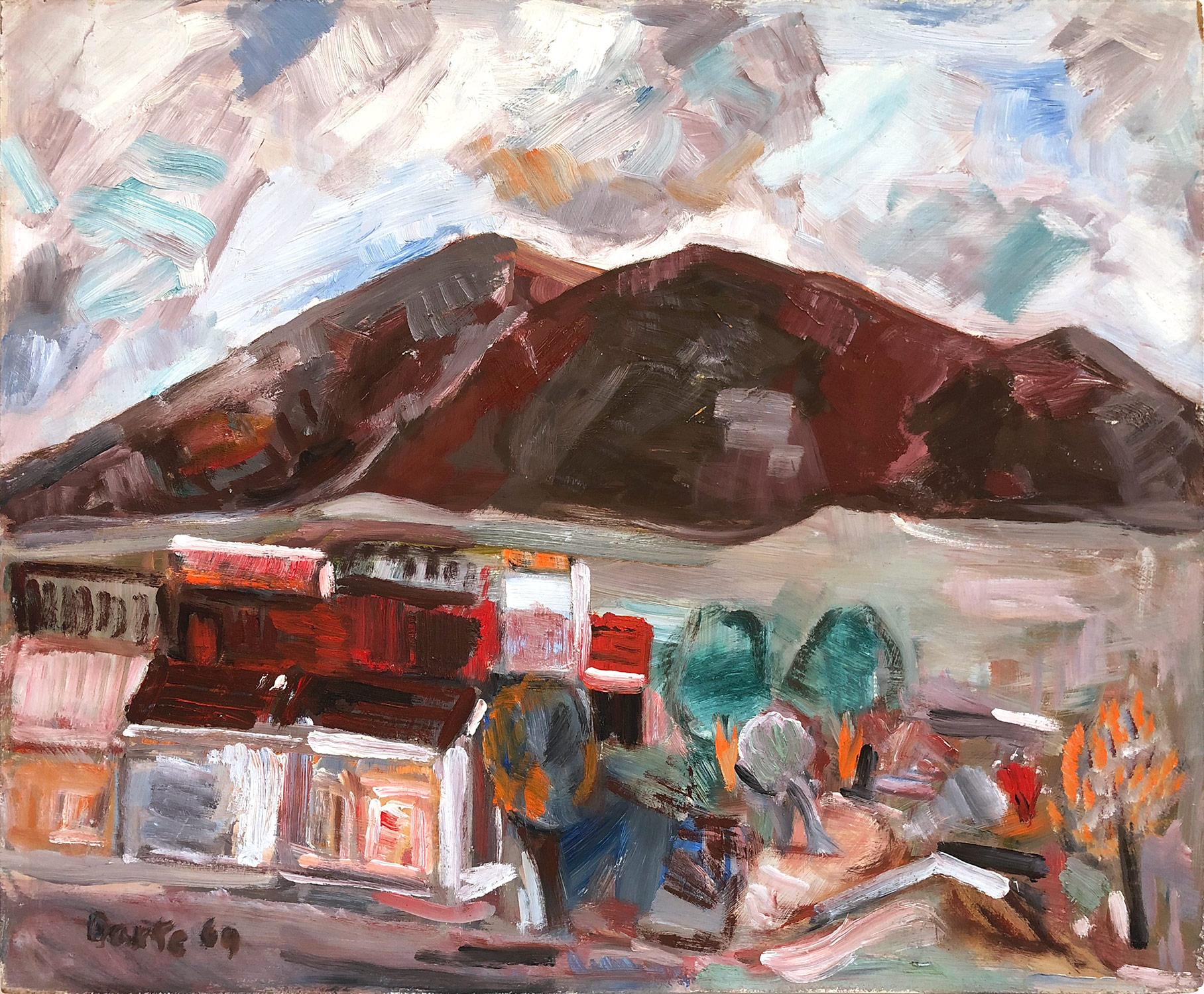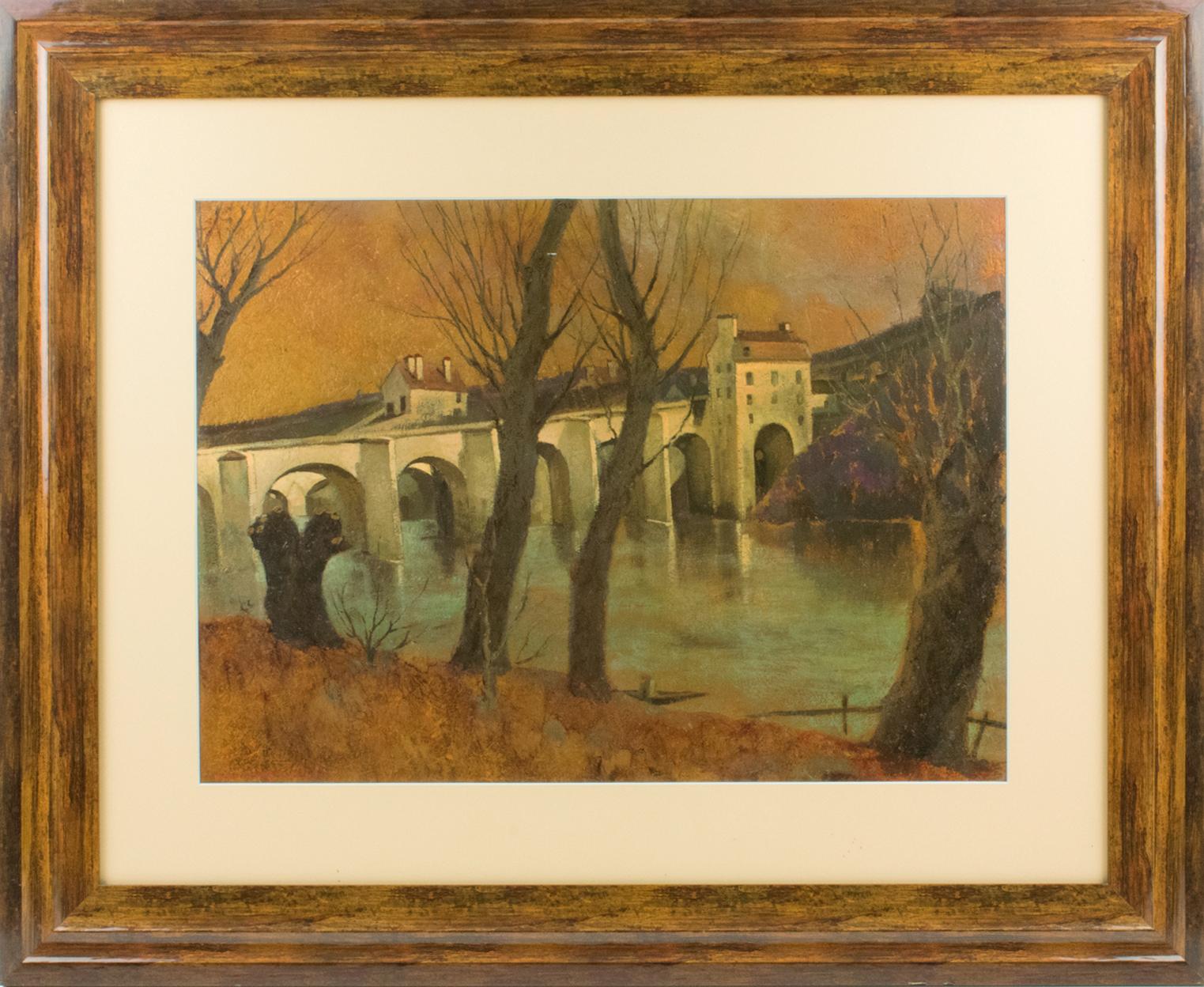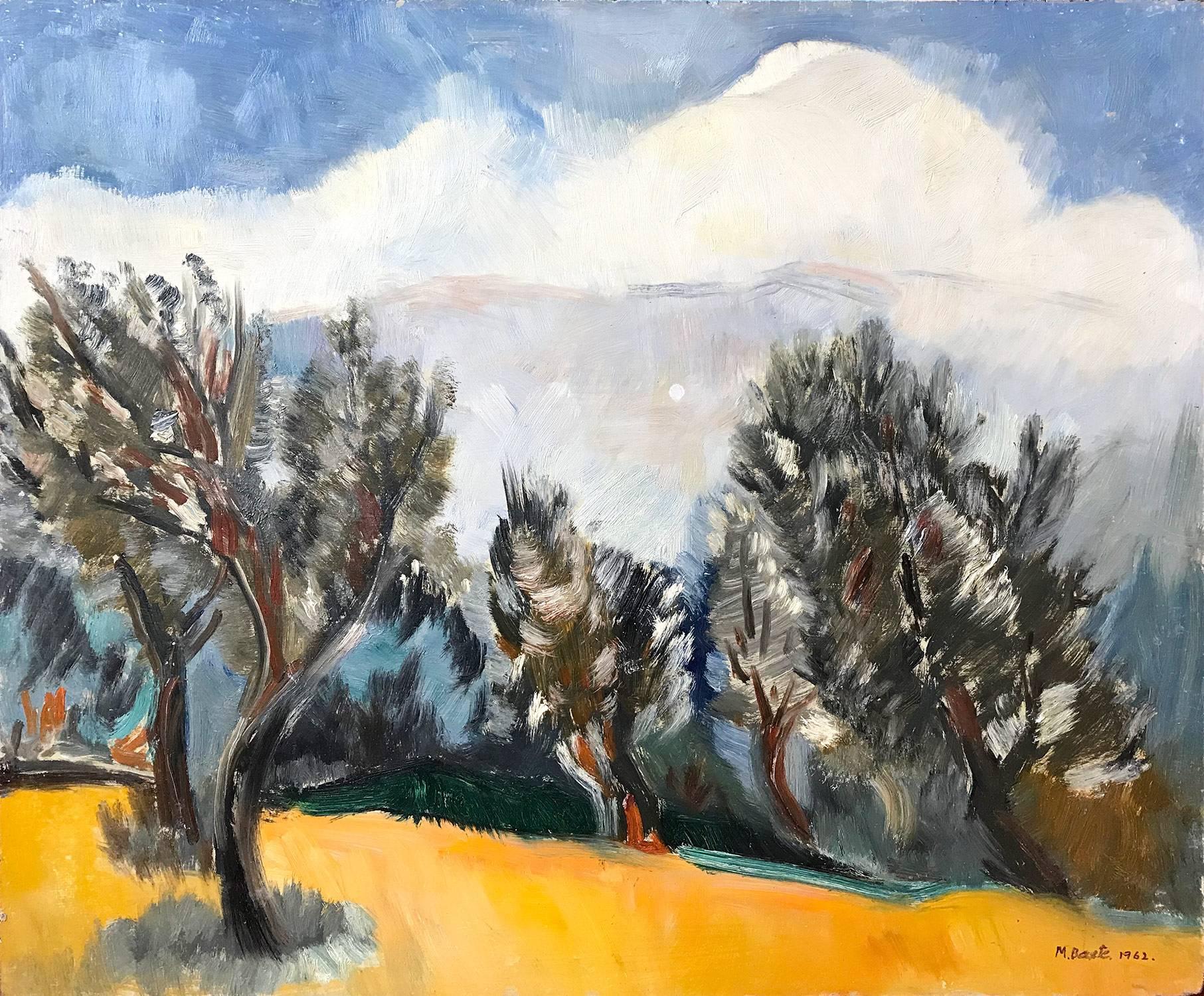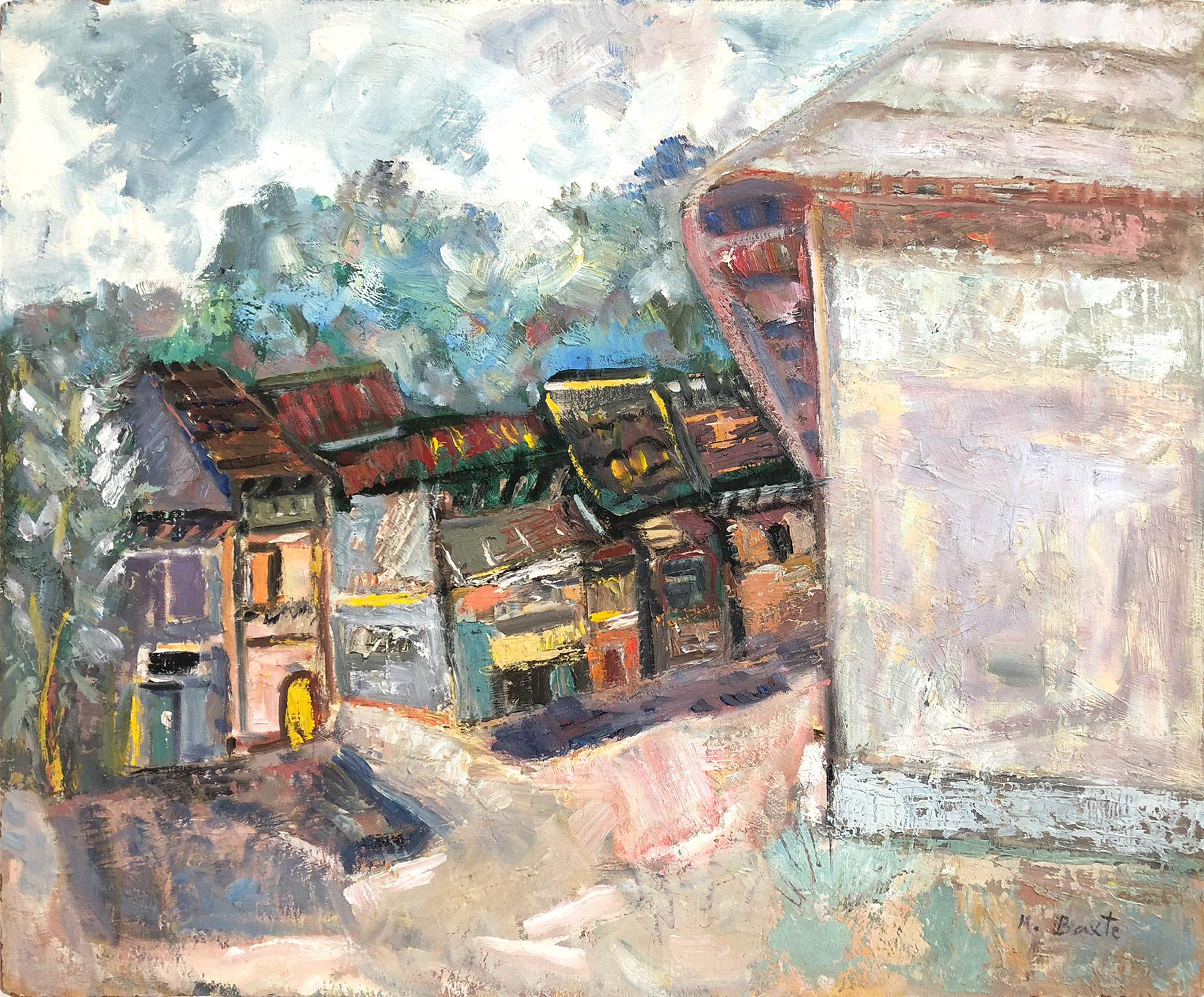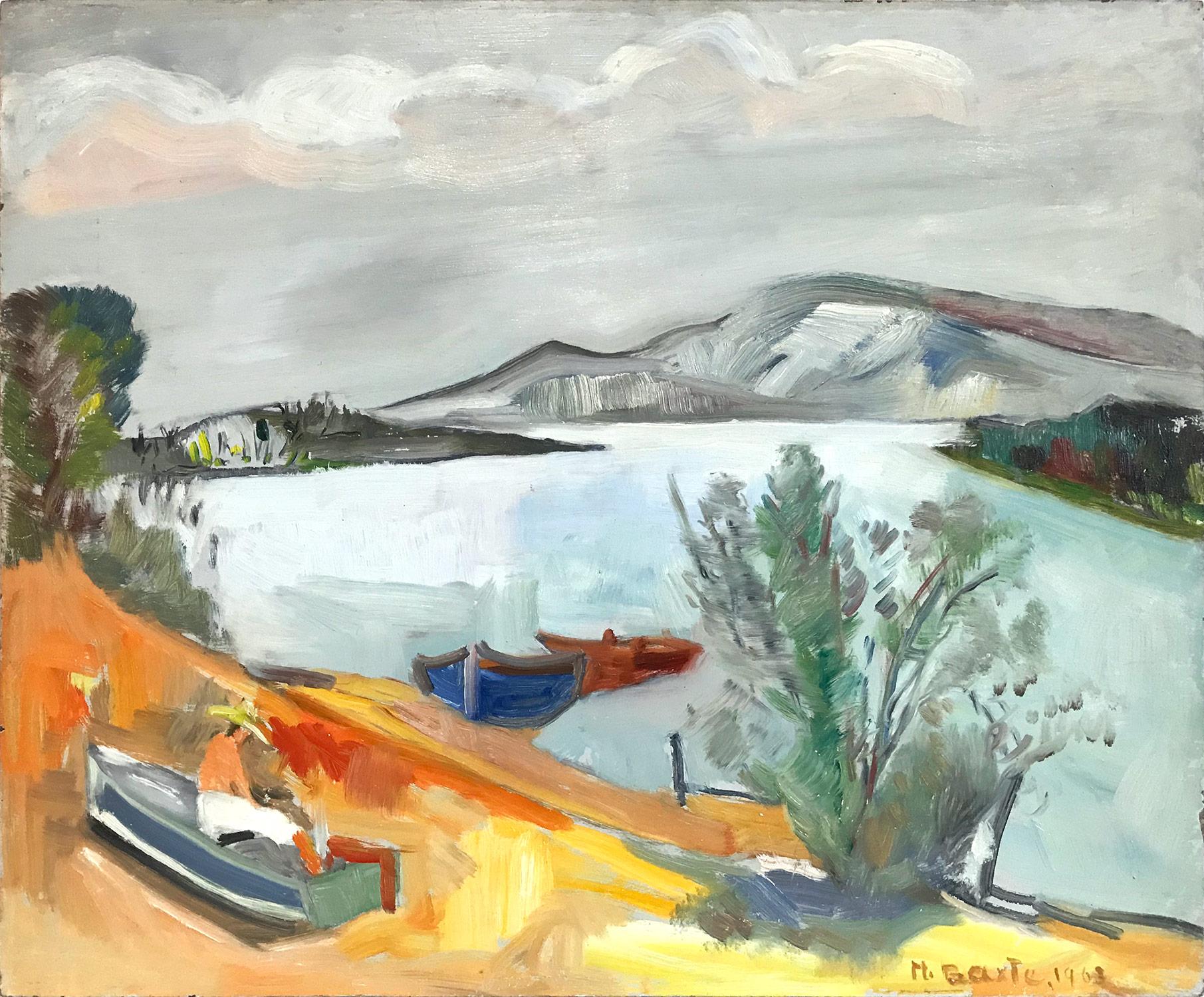Items Similar to 'Breaking Waves Off Monterey', California Expressionist Oil Seascape, Carmel
Want more images or videos?
Request additional images or videos from the seller
1 of 12
Robert Canete'Breaking Waves Off Monterey', California Expressionist Oil Seascape, CarmelCirca 1985
Circa 1985
About the Item
Signed lower left "Canete" for Robert Canete (American, born 1948), and painted circa 1990. This Carmel artist first studied with Vincent Rascon in the 1960s and, later, with Dwight Miller at Stanford.
An Expressionist-style seascape showing a view of the Pacific Ocean with big waves breaking off the coast of Monterey's Asilomar Beach. Bold, forward composition combines with gestural brushwork and a vibrant palette to form this dynamic work.
- Creator:Robert Canete (1948, American)
- Creation Year:Circa 1985
- Dimensions:Height: 16.13 in (40.98 cm)Width: 20 in (50.8 cm)Depth: 0.13 in (3.31 mm)
- Medium:
- Movement & Style:
- Period:
- Condition:minor restoration, minor marks; unframed.
- Gallery Location:Santa Cruz, CA
- Reference Number:1stDibs: LU3444775362
About the Seller
5.0
Platinum Seller
These expertly vetted sellers are 1stDibs' most experienced sellers and are rated highest by our customers.
Established in 1982
1stDibs seller since 2013
629 sales on 1stDibs
Typical response time: <1 hour
- ShippingRetrieving quote...Ships From: Santa Cruz, CA
- Return PolicyA return for this item may be initiated within 3 days of delivery.
More From This SellerView All
- 'Fishing Boats Off Monterey', Carmel, California Expressionist Seascape, Big SurBy Robert CaneteLocated in Santa Cruz, CASigned center right, "Canete", for Robert Canete, a Carmel artist who studied with Vincent Rascon in the 1960s and, later, with Dwight Miller at Stanford. A colorful Expressionist...Category
21st Century and Contemporary Expressionist Landscape Paintings
MaterialsPaper, Oil
- 'Spring Landscape', Paris, Danish Post-Impressionist oil, Charlottenborg PalaceBy Ejnar KraghLocated in Santa Cruz, CAA substantial, sunlit landscape showing a fruit-tree in blossom in the foreground with verdant fields receding towards rolling hills beneath turquoise and lavender clouds. Signed ...Category
1940s Expressionist Landscape Paintings
MaterialsOil, Canvas
- 'Waves off the Coast', Monterey, California, Large Modernist SeascapeBy Alberto ContiLocated in Santa Cruz, CASigned lower right "A. Conti" for Alberto Conti (Italian, 1895-1982) and painted circa 1960. A dramatic Expressionist style coastal scene showing a view of a breaking wave off the c...Category
Mid-20th Century Expressionist Landscape Paintings
MaterialsOil, Board
- 'Coastline', Expressionist California Landscape, San Francisco Woman ArtistBy Alice BeamishLocated in Santa Cruz, CAA dramatic, Expressionist Coastal landscape showing a view of white-capped jade green breakers crashing against a rocky shoreline, with a distant mountain painted in shades of scarlet, slate blue, and indigo rising in the background. Signed lower right, "Beamish", titled verso and painted circa 1960. Provenance: The Vincent Price Collection...Category
1950s Expressionist Abstract Paintings
MaterialsCanvas, Oil
- 'Fishermen's Cottages, Old Monterey', California Expressionist, Stanford, CarmelBy Robert CaneteLocated in Santa Cruz, CASigned center left, 'Canete' for Robert Canete and painted circa 2000. A vibrant Expressionist-style marine painting showing an aerial view of a sailing boat rounding a headland bes...Category
21st Century and Contemporary Expressionist Landscape Paintings
MaterialsPaper, Oil
- 'Hidden Cove, Carmel', Expressionist California Coastal Landscape Oil, MontereyBy Robert CaneteLocated in Santa Cruz, CASigned upper right, 'Canete' for Robert Canete and painted circa 2000. A vibrant Expressionist-style marine painting showing a view of a Cypress overlooking a California beach. Th...Category
21st Century and Contemporary Expressionist Landscape Paintings
MaterialsOil, Paper
You May Also Like
- Vaulted Bridge in French Landscape Oil on Wood Painting by Vincent MazzocchiniLocated in Atlanta, GAVincent Mazzocchini (France, 20th Century) created this unique French landscape oil on pressed wood board painting. This delightful composition is on rather unusual media. The lands...Category
1940s Expressionist Landscape Paintings
MaterialsWood, Masonite, Oil
- "Mexican Countryside Landscape Mountain Scene with Trees" Expressionistic StyleBy Michael BaxteLocated in New York, NYA strong modernist oil painting depicted in 1962 by Russian painter Michael Baxte. Mostly known for his abstracted figures on canvas or street scenes, this piece is a wonderful repre...Category
1960s Expressionist Landscape Paintings
MaterialsMasonite, Oil
- "Landscape of a Village Near Mountains" Expressionistic Oil Painting on MasoniteBy Michael BaxteLocated in New York, NYA strong modernist oil painting depicted in 1969 by Russian painter Michael Baxte. Mostly known for his abstracted figures on canvas or street scenes, this piece is a wonderful representation of his bold still life paintings, with expressive use of color, shape, and form. Later in his career, Baxte explores Expressionism, infusing both European and North American stylistic trends. This piece is from later in his career, but we can feel this underlying style throughout. Art measures 18 x 21.75 inches Michael Posner Baxte was born in 1890 in the small town of Staroselje Belarus, Russia. For the first half of the 19th century it was a center of the Chabad movement of Hasidic Jews, but this group was gone by the middle of the 19th century. By the time the Baxte family immigrated to the United States at the beginning of the 20th century, the Jewish population numbered only on the hundreds. The native language of the Baxte family was Yiddish. It is likely that the death of Michael Baxte’s father triggered the family’s immigration. Three older brothers arrived in New York between 1903 and 1905. Michael and his mother, Rebecca, arrived in 1907. By 1910 Michael, his mother, and brother, Joseph, were living in New Orleans and may have spent some time on a Louisiana plantation. Around 1912, Michael Baxte returned to Europe to study the violin. In 1914 he, his mother, and Joseph moved to New York City. Meanwhile, in Algeria, a talented young woman painter, Violette Mege, was making history. Since for the first time, a woman won the prestigious Beaux Art competition in Algeria. At first, the awards committee denied her the prize but, with French government intervention, Mege eventually prevailed. She won again 3 years later and, in 1916, used the scholarship to visit the United States of America. When Violette came to New York, she met Baxte, who was, by then, an accomplished violinist, teacher, and composer. Baxte’s compositions were performed at the Tokyo Imperial Theater, and in 1922 he was listed in the American Jewish Yearbook as one of the prominent members of the American Jewish community. As a music teacher he encouraged individual expression. Baxte stated, “No pupil should ever be forced into imitation of the teacher. Art is a personal experience, and the teacher’s truest aim must be to awaken this light of personality through the patient light of science.” By 1920 Michael Baxte and Violette Mege were living together in Manhattan. Although they claimed to be living as husband and wife, it seems that their marriage did not become official until 1928. On their “unofficial” honeymoon around 1917, in Algiers, Baxte confided to her his ambition to paint. There and later in New Mexico where the wonderful steeped sunlight approximates the coloring of Algiers, she taught him his heart’s desire. He never had any other teacher. She never had any other pupil. For ten years she devoted all her time, energy, and ambition to teaching, encouraging, inspiring him. Then in 1928, their mutual strivings were rewarded, as his works were being chosen as one of the two winners in the Dudensing National Competition for American Painters. Out of 150 artists from across the country participated in the Dudensing, and Michael Posner Baxte and, Robert Fawcett, were the winners. In his 1924 naturalization application, he indicated that he was sometimes known as “Michael Posner Baxte.” One of the witnesses to his application was Bernard Karfiol, a Jewish American artist. That’s when Michael may...Category
1960s Expressionist Landscape Paintings
MaterialsMasonite, Oil
- "Landscape Scene of Mexican Villagers" Expressionistic Oil Painting on MasoniteBy Michael BaxteLocated in New York, NYA strong modernist oil painting depicted in 1971 by Russian painter Michael Baxte. Mostly known for his abstracted figures on canvas or street scenes, this piece is a wonderful representation of his landscape paintings, with expressive use of color, shape, and form. Later in his career, Baxte explores Expressionism, infusing both European and North American stylistic trends. This piece is from later in his career, but we can feel this underlying style throughout. Art measures 18 x 21.75 inches Michael Posner Baxte was born in 1890 in the small town of Staroselje Belarus, Russia. For the first half of the 19th century it was a center of the Chabad movement of Hasidic Jews, but this group was gone by the middle of the 19th century. By the time the Baxte family immigrated to the United States at the beginning of the 20th century, the Jewish population numbered only on the hundreds. The native language of the Baxte family was Yiddish. It is likely that the death of Michael Baxte’s father triggered the family’s immigration. Three older brothers arrived in New York between 1903 and 1905. Michael and his mother, Rebecca, arrived in 1907. By 1910 Michael, his mother, and brother, Joseph, were living in New Orleans and may have spent some time on a Louisiana plantation. Around 1912, Michael Baxte returned to Europe to study the violin. In 1914 he, his mother, and Joseph moved to New York City. Meanwhile, in Algeria, a talented young woman painter, Violette Mege, was making history. Since for the first time, a woman won the prestigious Beaux Art competition in Algeria. At first, the awards committee denied her the prize but, with French government intervention, Mege eventually prevailed. She won again 3 years later and, in 1916, used the scholarship to visit the United States of America. When Violette came to New York, she met Baxte, who was, by then, an accomplished violinist, teacher, and composer. Baxte’s compositions were performed at the Tokyo Imperial Theater, and in 1922 he was listed in the American Jewish Yearbook as one of the prominent members of the American Jewish community. As a music teacher he encouraged individual expression. Baxte stated, “No pupil should ever be forced into imitation of the teacher. Art is a personal experience, and the teacher’s truest aim must be to awaken this light of personality through the patient light of science.” By 1920 Michael Baxte and Violette Mege were living together in Manhattan. Although they claimed to be living as husband and wife, it seems that their marriage did not become official until 1928. On their “unofficial” honeymoon around 1917, in Algiers, Baxte confided to her his ambition to paint. There and later in New Mexico where the wonderful steeped sunlight approximates the coloring of Algiers, she taught him his heart’s desire. He never had any other teacher. She never had any other pupil. For ten years she devoted all her time, energy, and ambition to teaching, encouraging, inspiring him. Then in 1928, their mutual strivings were rewarded, as his works were being chosen as one of the two winners in the Dudensing National Competition for American Painters. Out of 150 artists from across the country participated in the Dudensing, and Michael Posner Baxte and, Robert Fawcett, were the winners. In his 1924 naturalization application, he indicated that he was sometimes known as “Michael Posner Baxte.” One of the witnesses to his application was Bernard Karfiol, a Jewish American artist. That’s when Michael may...Category
1960s Expressionist Landscape Paintings
MaterialsMasonite, Oil
- "Colorful Mexican Village Scene" Expressionistic Oil Painting on MasoniteBy Michael BaxteLocated in New York, NYA strong modernist oil painting depicted Circa 1960 by Russian painter Michael Baxte. Mostly known for his abstracted figures on canvas or street scenes, this piece is a wonderful representation of his bold still life paintings, with expressive use of color, shape, and form. Later in his career, Baxte explores Expressionism, infusing both European and North American stylistic trends. This piece is from later in his career, but we can feel this underlying style throughout. Art measures 18 x 21.75 inches Michael Posner Baxte was born in 1890 in the small town of Staroselje Belarus, Russia. For the first half of the 19th century it was a center of the Chabad movement of Hasidic Jews, but this group was gone by the middle of the 19th century. By the time the Baxte family immigrated to the United States at the beginning of the 20th century, the Jewish population numbered only on the hundreds. The native language of the Baxte family was Yiddish. It is likely that the death of Michael Baxte’s father triggered the family’s immigration. Three older brothers arrived in New York between 1903 and 1905. Michael and his mother, Rebecca, arrived in 1907. By 1910 Michael, his mother, and brother, Joseph, were living in New Orleans and may have spent some time on a Louisiana plantation. Around 1912, Michael Baxte returned to Europe to study the violin. In 1914 he, his mother, and Joseph moved to New York City. Meanwhile, in Algeria, a talented young woman painter, Violette Mege, was making history. Since for the first time, a woman won the prestigious Beaux Art competition in Algeria. At first, the awards committee denied her the prize but, with French government intervention, Mege eventually prevailed. She won again 3 years later and, in 1916, used the scholarship to visit the United States of America. When Violette came to New York, she met Baxte, who was, by then, an accomplished violinist, teacher, and composer. Baxte’s compositions were performed at the Tokyo Imperial Theater, and in 1922 he was listed in the American Jewish Yearbook as one of the prominent members of the American Jewish community. As a music teacher he encouraged individual expression. Baxte stated, “No pupil should ever be forced into imitation of the teacher. Art is a personal experience, and the teacher’s truest aim must be to awaken this light of personality through the patient light of science.” By 1920 Michael Baxte and Violette Mege were living together in Manhattan. Although they claimed to be living as husband and wife, it seems that their marriage did not become official until 1928. On their “unofficial” honeymoon around 1917, in Algiers, Baxte confided to her his ambition to paint. There and later in New Mexico where the wonderful steeped sunlight approximates the coloring of Algiers, she taught him his heart’s desire. He never had any other teacher. She never had any other pupil. For ten years she devoted all her time, energy, and ambition to teaching, encouraging, inspiring him. Then in 1928, their mutual strivings were rewarded, as his works were being chosen as one of the two winners in the Dudensing National Competition for American Painters. Out of 150 artists from across the country participated in the Dudensing, and Michael Posner Baxte and, Robert Fawcett, were the winners. In his 1924 naturalization application, he indicated that he was sometimes known as “Michael Posner Baxte.” One of the witnesses to his application was Bernard Karfiol, a Jewish American artist. That’s when Michael may...Category
1960s Expressionist Landscape Paintings
MaterialsMasonite, Oil
- "Landscape Scene of Fisherman by Lake" Expressionistic Oil Painting on MasoniteBy Michael BaxteLocated in New York, NYA strong modernist oil painting depicted in 1963 by Russian painter Michael Baxte. Mostly known for his abstracted figures on canvas or street scenes, this piece is a wonderful representation of his figures in water landscapes with expressive use of color, shape, and form. Later in his career, Baxte explores Expressionism, infusing both European and North American stylistic trends. This piece is from later in his career, but we can feel this underlying style throughout. Art measures 18 x 21.75 inches Michael Posner Baxte was born in 1890 in the small town of Staroselje Belarus, Russia. For the first half of the 19th century it was a center of the Chabad movement of Hasidic Jews, but this group was gone by the middle of the 19th century. By the time the Baxte family immigrated to the United States at the beginning of the 20th century, the Jewish population numbered only on the hundreds. The native language of the Baxte family was Yiddish. It is likely that the death of Michael Baxte’s father triggered the family’s immigration. Three older brothers arrived in New York between 1903 and 1905. Michael and his mother, Rebecca, arrived in 1907. By 1910 Michael, his mother, and brother, Joseph, were living in New Orleans and may have spent some time on a Louisiana plantation. Around 1912, Michael Baxte returned to Europe to study the violin. In 1914 he, his mother, and Joseph moved to New York City. Meanwhile, in Algeria, a talented young woman painter, Violette Mege, was making history. Since for the first time, a woman won the prestigious Beaux Art competition in Algeria. At first, the awards committee denied her the prize but, with French government intervention, Mege eventually prevailed. She won again 3 years later and, in 1916, used the scholarship to visit the United States of America. When Violette came to New York, she met Baxte, who was, by then, an accomplished violinist, teacher, and composer. Baxte’s compositions were performed at the Tokyo Imperial Theater, and in 1922 he was listed in the American Jewish Yearbook as one of the prominent members of the American Jewish community. As a music teacher he encouraged individual expression. Baxte stated, “No pupil should ever be forced into imitation of the teacher. Art is a personal experience, and the teacher’s truest aim must be to awaken this light of personality through the patient light of science.” By 1920 Michael Baxte and Violette Mege were living together in Manhattan. Although they claimed to be living as husband and wife, it seems that their marriage did not become official until 1928. On their “unofficial” honeymoon around 1917, in Algiers, Baxte confided to her his ambition to paint. There and later in New Mexico where the wonderful steeped sunlight approximates the coloring of Algiers, she taught him his heart’s desire. He never had any other teacher. She never had any other pupil. For ten years she devoted all her time, energy, and ambition to teaching, encouraging, inspiring him. Then in 1928, their mutual strivings were rewarded, as his works were being chosen as one of the two winners in the Dudensing National Competition for American Painters. Out of 150 artists from across the country participated in the Dudensing, and Michael Posner Baxte and, Robert Fawcett, were the winners. In his 1924 naturalization application, he indicated that he was sometimes known as “Michael Posner Baxte.” One of the witnesses to his application was Bernard Karfiol, a Jewish American artist. That’s when Michael may...Category
1960s Expressionist Landscape Paintings
MaterialsMasonite, Oil
Recently Viewed
View AllMore Ways To Browse
Breaking Vintage
Vintage Breaks
Vintage Wave Art
California Seascape Painting
California Coast Beach Painting
Big Wave
Breaking Wave
California Carmel Landscape Paintings
Ocean Waves Oil Painting
Ocean Waves Oil
Oil Paintings Of Ocean Waves
Monterey Landscape
Ocean Waves Seascape
California Seascape Oil
Oil California Seascape Painting
California Landscape Monterey
Beach Waves Oil Painting
Monterey Carmel Painting
